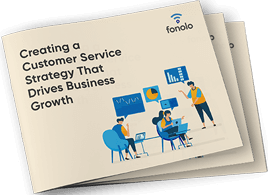After-call surveys give you rich insights into your call center’s day-to-day operations. They’re kind of like customer satisfaction surveys, except they’re sent to a customer immediately after an agent-customer interaction. Why does the immediate timing matter?
There’s something special about the after-call survey’s authenticity. Think of freshly baked chocolate cookies right out of the oven. You could eat them later in the week, but you won’t experience the same soft dough and delectable, melt-in-your-mouth gooey chocolate. It just doesn’t taste the same.
After-call surveys are similar. The immediate insight into the customer experience is rich with fresh insights you can use to improve your customer service strategy and learn more about your call center. But asking the right questions is key to solid survey results. Read on for our top questions to include in your after-call surveys.
3 Tips for a Great After-Call Survey
As you craft your survey template, mull over these three important considerations to improve your after-call surveys.
Keep it short and sweet
Respect your customer’s time and keep the after-call survey quick. Don’t worry—we’ll cover some high-value questions that’ll offer your contact center solid insights.
Don’t rely only on open-ended questions
Sure, open-ended questions offer customers the chance to vent their feelings. But right after a phone call, they might be in a rush to end the interaction. Post-call surveys should feel breezy for the customer, so multiple-choice or scaled questions are a great way to go.
Offer multi-format after-call surveys
Why limit survey data to just phone calls? Invite customer feedback through every channel, including SMS, email, and chat.
7 Great Questions to Ask in After-call Surveys
1. Was it easy to find our contact information?
Accessibility goes beyond offering physically accessible spaces like wheelchair-accessible bathrooms. Your call center should consider it in every business process, including inbound calls. That includes making contact information easy to find, easy to read, and available in alternate formats; in other words, make it accessible!
DID YOU KNOW?:
Fonolo’s Web Call-Backs (formerly Visual IVR) is ARIA-compliant and accessible to people with disabilities.
2. How long did you wait on hold?
Hold times shouldn’t be exorbitantly long—but if they are, the IVR software should inform the customer of their place in line or offer a call-back.
Over 54 million Americans have a disability, including neurodevelopmental disorders, motor issues, and learning disabilities that might make waiting on hold with no explanation more difficult. And for customers without disabilities? An accessible call center is simply good customer service
3. On a scale of 1-10, how knowledgeable was the call center agent you spoke with about your inquiry?
As call center leaders, you already know that many moving parts impact agent performance. Training, staffing levels, recruitment, and agent engagement all play a role. But after-call surveys offer some insight, too.
Poor understanding of the customer’s inquiry or the company products indicates a hiccup. That hiccup may be a small part of a bigger problem, but it’s enough to raise a flag for further investigation. You can pair this insight with other KPIs and metrics to paint a broader picture. Questions that are framed with an ordinal scale offer your contact center valuable qualitative data to understand your customer experience.
4. Was it easy to understand the call center agent?
This is another great accessibility question. You might use a likert scale for responses, asking the customer to rate their agreement with the statement on a scale from 1-5. Unclear conversations could be the result of poor tech, lack of agent confidence, or even overlooked accessibility standards like offering options for people who are hard of hearing.
5. Did you solve your problem?
Three words: first-call resolution, or FCR. This question gives you insight into this valuable metric that speaks to both service quality and operational efficiency. It also wins accessibility points because it measures service time.
Our next question dives deeper…
6. Why didn’t you solve your problem in the call?
This is a great multiple-choice question. Low FCR rates are worth exploring, and this question does just that. You might offer options like:
- Poor technology or connection
- Unhelpful agent
- Escalation
- Long wait time
7. Are you satisfied with our service? If so, which aspects are you satisfied with?
Product and services pricing? Agent tone of voice? Expert knowledge? Quick resolution? List anything positive in this question’s multiple choices. It’s a great question to identify the good things going on in your call center. A nice bonus? You can use positive feedback to boost employee engagement.


